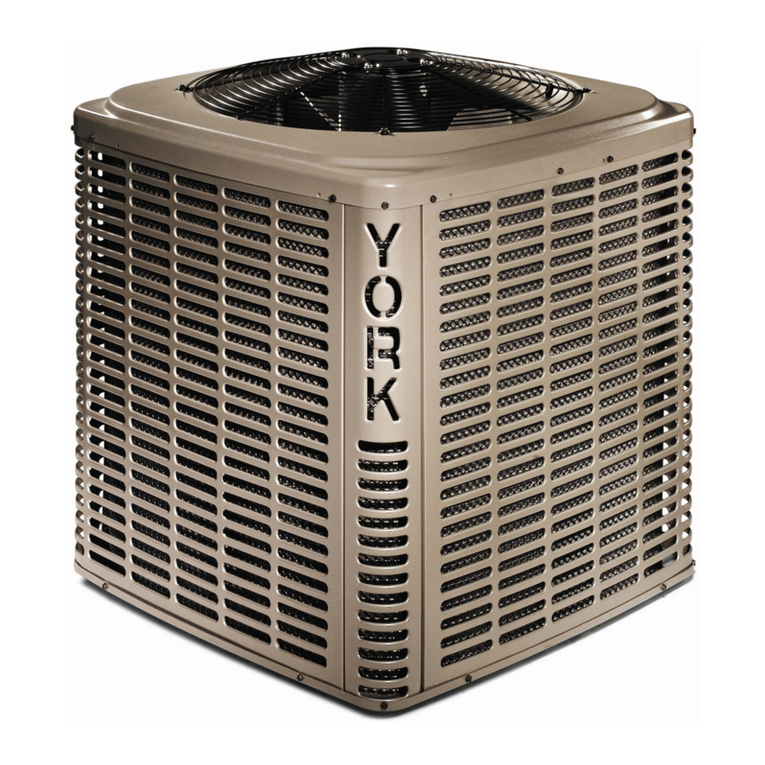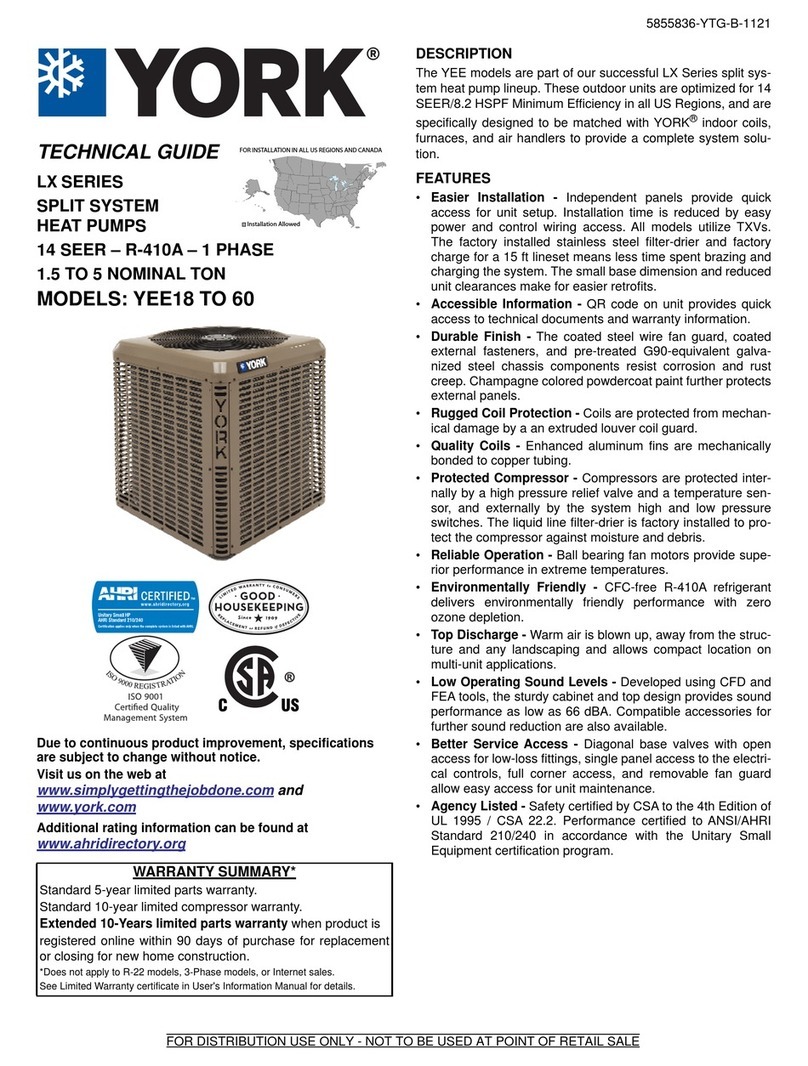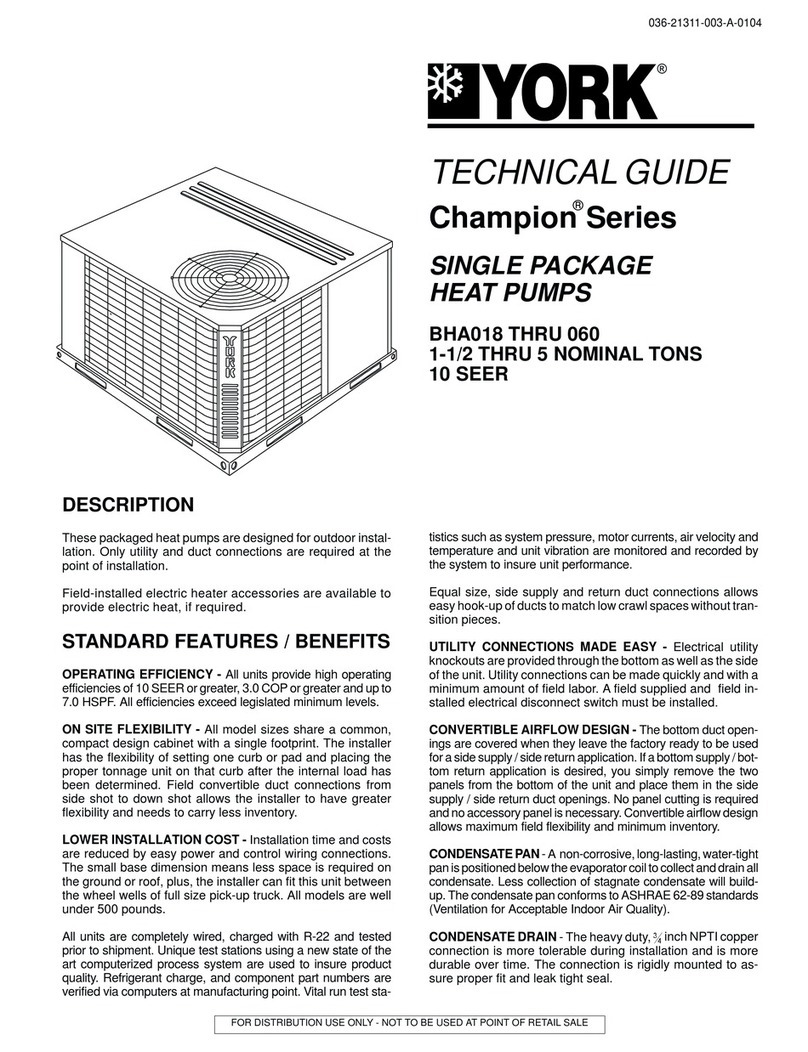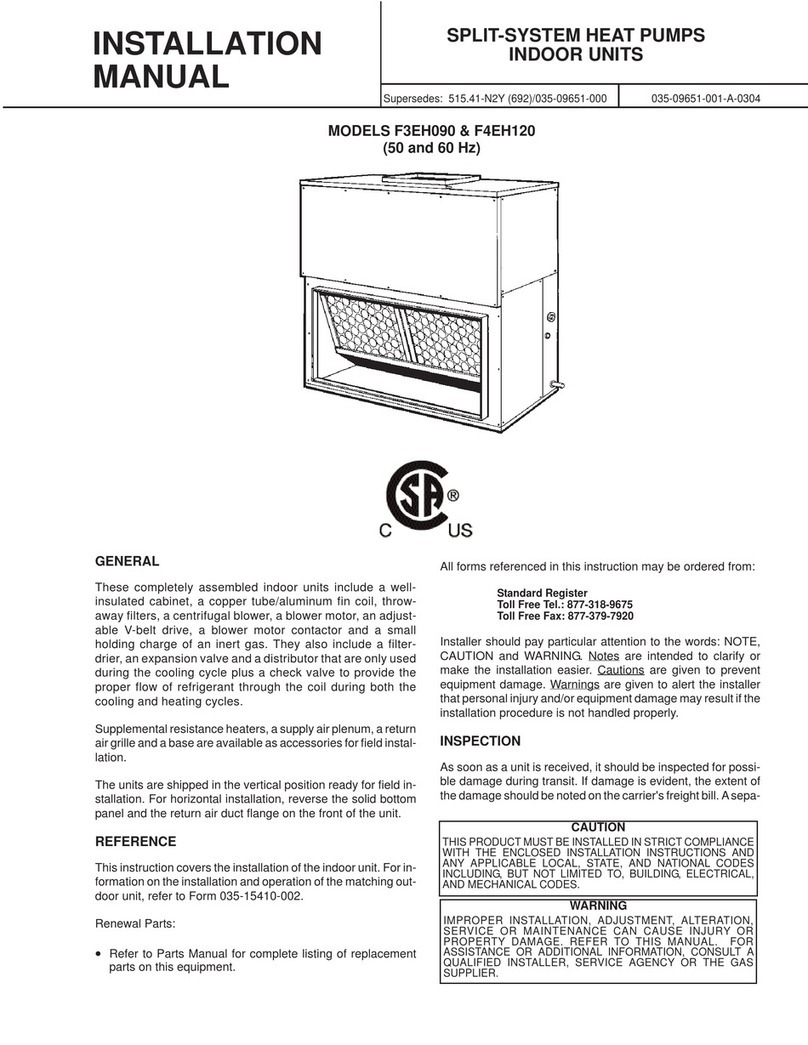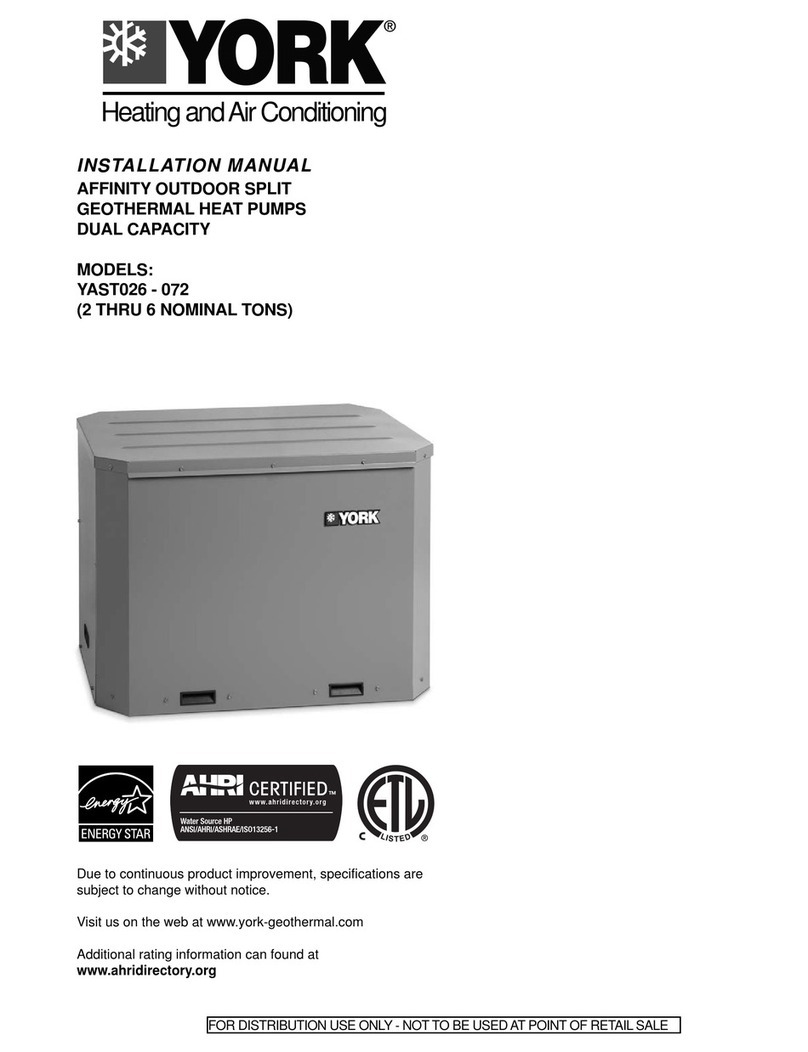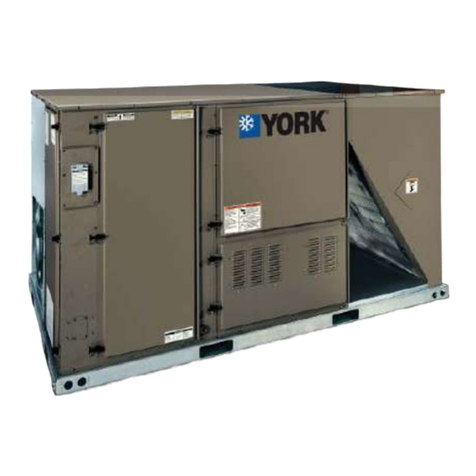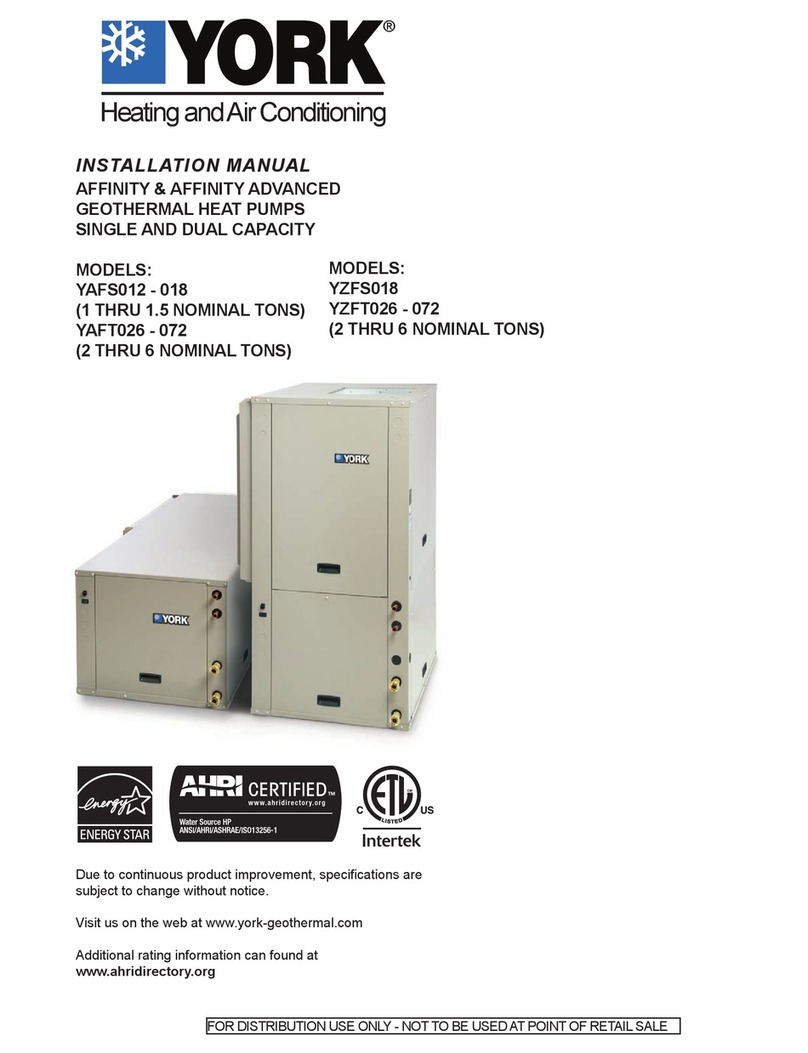
174683-UUM-A-0106
2Unitary Products Group
Fan Operation Selection
A multi-position fan switch allows you to choose the type of fan opera-
tion of the indoor fan.
AUTO - With the thermostat fan switch set to “AUTO”, the fan will run
intermittently as required for either heating or cooling. This position will
provide the lowest operating cost. If you purchased one of our thermo-
stats, they have an Intelligent fan mode which continually circulates the
air during occupied modes or when you are at home, and can cycle the
fan during unoccupied mode or during the night while you sleep to fur-
ther conserve energy.
ON - If the fan switch is set to “ON”, the indoor fan will not shut off. How-
ever, the system will still operate as required by room temperatures.
This provides continuous air filtering and more even temperature distri-
bution throughout the house, which is especially useful in houses with
basements.
Usually during spring and fall, when neither heating nor cooling is
required, you may want to run only the fan to ventilate, circulate, and fil-
ter the air in your home or building. Set the comfort control switch to
“OFF” and the fan switch to “ON”. Be sure to return the switches to their
original positions for normal operation.
Heating Cycle
With the thermostat in the heating position, and the outdoor tempera-
ture in the range of 20 to 30° or below, the outdoor unit will generally run
100%of the time.
All systems can be equipped with balance point control to provide even
more efficient operation. This control will prevent the electric heater
from being energized when the outdoor air is above some predeter-
mined temperature setting (0 to 45°F). At higher temperatures, your
system will provide all the heat your home will ever need. At lower tem-
peratures, the auxiliary heat will be energized to keep your home com-
fortable.
When the outdoor air is cool and moist, frost may form on the surface of
your outdoor coil. When this frost builds to a certain point, your system
will switch to a defrost cycle. Although you may feel cooler air coming
from your registers, DO NOT adjust your thermostat. The frost will melt
quickly, and your system will return to normal operation automatically.
Cooling Cycle
Switch your thermostat to cool.Select a comfortable thermostat temper-
ature setting, typically between 75 and 80°. Comfort sensations vary
with individuals. The lower the indoor temperature desired, the greater
will be the number of hours your unit must operate.
Set your thermostat 2 or 3°F below normal several hours before enter-
taining large groups during hot weather. People give off considerable
heat and moisture.
On an extremely hot day, the indoor temperature may rise 3 to 6°F
above the thermostat setting. Properly selected equipment does not
have the capacity to maintain a constant indoor temperature during the
peak load. Over-sizing your system to handle this peak load is not prac-
tical because the oversized system would operate much less efficiently
at all other conditions.
TO MAXIMIZE OPERATING EFFICIENCY
HEATING CONSERVATION
For the most efficient operation, keep storm windows and doors closed
all year long. They not only help insulate against heat and cold, but they
also keep out dirt, pollen and noise.
Closing drapes at night, keeping fireplace dampers closed when not in
use, and running exhaust fans only when necessary will help you to
retain the air you have already paid to heat.
Keep lamps, televisions, or other heat producing sources away from the
thermostat. The thermostat will sense this extra heat and will not be
able to maintain the inside temperature to the desired comfort level.
COOLING CONSERVATION
To comfortably cool your home, your heat pump must remove both heat
and humidity. Don’t turn your system off even though you will be away
all day. On a hot day, your system may have to operate between 8 to 12
hours to reduce the temperature in your home to a normal comfort level.
Keep windows closed after sundown. While the outdoor temperature at
night may be lower than indoors, the air is generally loaded with mois-
ture which is soaked up by furniture, carpets, and fabrics. This moisture
must be removed when you restart your system.
The hotter the outside temperature, the greater the load on your sys-
tem. Therefore do not be alarmed when your system continues to run
after the sun has set on a hot day. Heat is stored in your outside walls
during the day and will continue to flow into your home for several hours
after sunset.
Use your kitchen exhaust fan when cooking. One surface burner on
“HIGH” requires one ton of cooling. Turn on your bathroom exhaust fan
while showering to remove humidity. However, exhaust fans should not
be run excessively. It would decrease efficiency by removing condi-
tioned air.
You can also help your system in the summer by closing drapes or
blinds and by lowering awnings on windows that get direct sunlight.
CARE OF SYSTEM
IMPORTANT: The Owner/user should not attempt to disassemble the
equipment nor perform the periodic maintenance unless they are expe-
rienced and qualified to do so.
A periodic inspection, cleaning, lubrication and adjustment of your heat
pump is available from your dealer. Be sure to ask him about this ser-
vice.
For those who prefer to do-it-yourself, follow the instructions below to
care for your system.
COIL CARE
Keep the outdoor unit free of loose snow, foliage, grass clippings,
leaves, paper, and any other material which could restrict the proper air
flow in and out of the unit. The coil may be vacuumed to remove any
debris from between the fins. However, don’t knock ice off the outdoor
unit’s coil surface following an ice or severe snowstorm. The blows
could mash the coil fins shut (blocking air passage), or break the refrig-
erant tubing allowing the refrigerant to escape.
If the coil becomes excessively dirty, turn the main disconnect switch to
“OFF” and wash the coil with your garden hose. Avoid getting water into
the fan motor and control box. Flush dirt from base pan after cleaning
the coil.
CARE OF FAN MOTORS
Some fan motors are provided with lubrication ports. Inspect your
indoor and outdoor units to determine whether or not lubrication ports
are provided.
The main power to the system must be kept “ON” at all times to
prevent damage to the outdoor unit compressor. If necessary,
the thermostat control switch should be used to turn the system
“OFF”. Should the main power be disconnected or interrupted
for 8 hours or longer, DO NOT attempt to start the system for 8
hours after the power has been restored to the outdoor unit. If
heat is needed during this 8 hour period, use emergency heat.

